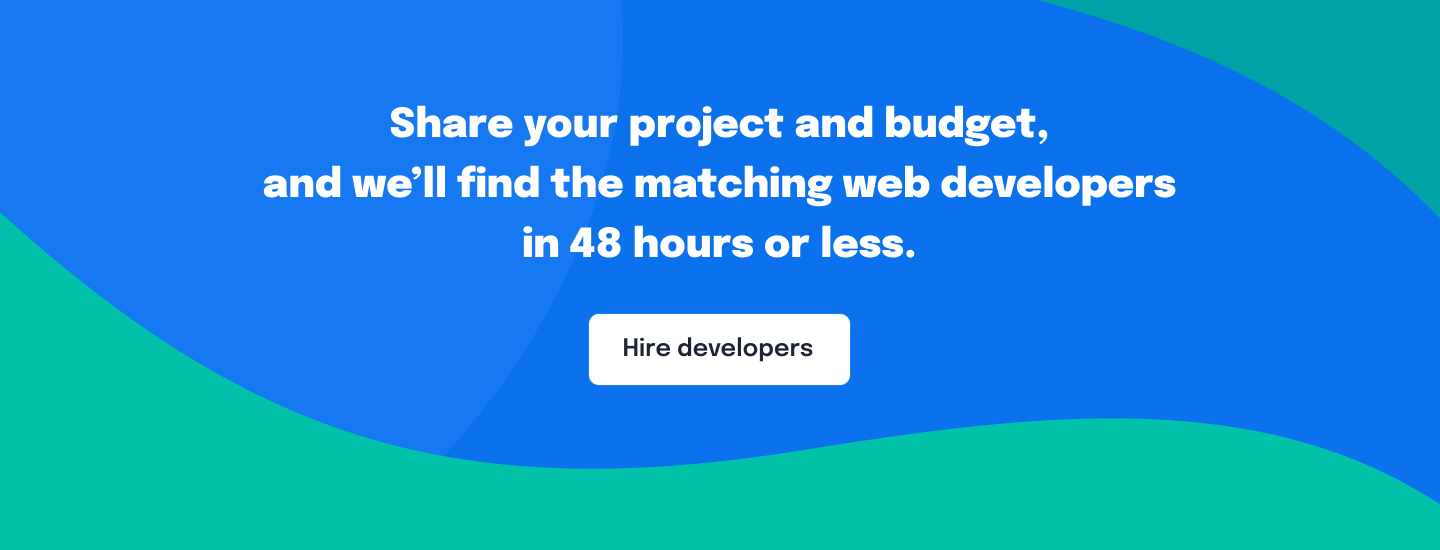When it comes to website application development, there are a lot of companies around the world that want to work with you. Website development companies invest time and effort in presenting themselves the right way and pitching for new work.
Deciding who to work with isn’t always an easy choice.
Table of Contents
How to choose a web app development company?
First, pricing can vary widely, with companies in Central and Eastern Europe, Mexico, and South East Asia being often more cost-effective than firms and freelancers in the U.S., UK, and Europe. Cost is always going to be an important part of the decision making process. Have a budget and aim to stick to it, but make sure you are working with the right partners for the development of your web application.
In this article, we cover the technology stack that is needed for website application development, the challenges involved in the development process, rough cost estimates, and mistakes to avoid when picking a development partner.
However, if you’re busy, YouTeam can help source the best web application development companies in offshore countries for you. Just let us know your needs, and we’ll source the best web app developers in 48 hours or less.
Web application technology stack: how to choose the best type
Although this might seem like a detail that will be buried deep in a proposal, it can play a key role in the success or failure of your website application. Picking the right tech stack, or working with a partner that can get this right, can make a big impact. It can also greatly influence the cost.
For larger companies with more complex project needs, a larger slice of the budget can go into building a robust tech stack. Whereas for startups and small and medium enterprises, you need a tech stack that will generate a sizeable ROI sooner rather than later. To give you more of an insight into what is involved, there are two sides to the technology stack for web applications: the client side, also known as the front-end, and the server side, or back-end.
At the front end is the interface web visitors/users experience and interact with, which usually involves one or two major technology stack components:
| Technology | Description |
| HTML and CSS | HTML for page structure, CSS for styling. Front-end developers use them to create and style web content. Collaborate with UX/UI designers for the user experience. |
| JavaScript (JS) | Manages interactive elements. Developers use libraries like jQuery, React.js, and frameworks like Angular and Vue for faster applications. |
Behind the scenes, at the back-end or server-side is where the majority of the work takes place. What goes on here entirely depends on the complexity of the project and what the application needs to interact with, such as APIs to connect it with other applications, or integrations with databases.
To create the server side of the application, web development companies need to create these elements using one or more programming languages. Some of the choices for this work include:
| Technology | Description |
| Ruby (Ruby on Rails) | A web development framework using Ruby, known for its simplicity and ease of use. |
| Python (Django, Flask, Pylons) | Python-based web development frameworks with Django (feature-rich), Flask (lightweight), and Pylons (flexible). |
| PHP (Laravel) | A PHP-based web development framework known for its elegant syntax and robust features. |
| Java (Spring) | A Java-based framework offering extensive features and tools for web application development. |
| Scala (Play) | A Scala-based web development framework known for its scalability and high performance. |
| Elixir | Elixir is used to create scalable and maintainable web applications to handle a large number of users. |
Most web applications have databases. In some cases, these need to be built from scratch, or an integration with a database that already exists needs to be created. Developers pick the right database for a project depending on whether it needs to be relational or non-relational. Some of the most popular choices for databases are:
| Technology | Description |
| MySQL | A relational database used for web applications. Developers choose it for projects requiring structured data and support for complex queries, joins, and transactions. |
| PostgreSQL | Another relational database commonly used in web applications. It offers advanced features and is preferred for data integrity and scalability. |
| MongoDB | A non-relational (NoSQL) database suitable for projects with unstructured or semi-structured data. It provides flexibility and horizontal scalability. |
Database development should include a caching system to reduce the load and increase the speed data is retrieved. Developers frequently use ELT (Extract, Load, Transform) procedures or specialized data migration tools to facilitate the smooth transfer of data from MongoDB, a non-relational database, to PostgreSQL, a relational database. These techniques guarantee data consistency and seamless integration between the two systems.
The final piece of this technology stack puzzle – alongside any other tech integrations – is the server itself, which is where this web application and its database will operate from. This also involves the developers making a choice when it comes to the technology within that server to run the application. Apache and Nginx are the two main choices in this market.
Now we’ve covered the technology that will play a key role in the development of your web application, let’s look at some of the most common challenges companies encounter during the web development process.
Common challenges during web application development
1. User experience (UX)
Surely one of the most important aspects of any web application. Whether you are developing a consumer app or a new corporate training platform, people expect a smooth, seamless, and quick user experience. The design makes a huge impact on the final outcome. How users move through an application needs to be well considered.
Time needs to be spent understanding what your end-users want and how to create an application that they want to use. Rushing through this process, or not giving developers and designers enough time to design the application could result in more work needed on this in the future to improve the user experience.
2. Scalability of your application
Web applications need to be built with scale in mind. How many people are you expecting to use your application at any one time? Will there be peak times when it is used? Where are your users (and how does this relate to where the server and database are located)?
All of these factors need to be taken into account when considering scale. And if the user-base starts relatively small, are you expecting it to increase over time? If so, make sure the server can handle an increase in traffic and database requests and that you understand that costs will increase when an application becomes more popular. Fortunately, there are many popular servers and hosting options that have flexibility and scale built-into the service offering, such as Amazon Web Services (AWS).
3. Speed of development
When it comes to web applications, speed is as crucial as the user experience. A beautifully designed application that loads quickly will attract more users as people expect applications and websites to load in under a second.
Depending on where your users/web visitors are, a Content Distribution Network (CDN), or range of proxy servers around the world might be needed to ensure it loads as quickly in overseas markets. A range of other factors, including how databases are configured and interrogations with APIs can influence loading speeds, so make sure testing is part of the process throughout and at the end of the application development.
4. Lack of tech stack knowledge
When working with a web development partner, it can be tempting to leave technology decisions with them. However, to ensure success, it is useful to have one or more staff members internally to manage the process, with enough knowledge and information to ask the right questions. Keep on top of the details during the development process, before key decisions are made, and it can save you a lot of time and trouble once an application is built.
5. Security of data and users
Security is an essential component of every web application.
Not only is this a gateway to your internal systems and servers, and therefore something that needs protecting from cybercriminals, but the cost of data breaches can cripple companies. In Europe, a preventable data breach can cost reputational damage and up to 4% of revenues, under GDPR, a more robust data protection law enacted in 2018.
Beyond the implementation of preventative services to block attacks, applications need to be coded carefully to reduce the risk of cyber-attacks and data breaches.
How much does web application development cost?
Costing a web application is never a straightforward process. To receive a better price estimate from an offshore company, make sure you have all the project specs in place. Try to think in advance of the features and edits you may require. From our experience, it is cheaper to negotiate the biggest scope of work in advance, then to submit additional feature requests in the development process. Your software development partner may use this as an opportunity to scale the check. Of course, when you are working with YouTeam, we monitor situations like that, however, we know how often they do occur in cases when a client didn’t think the whole project scope in advance.
The process of cost estimation involves creating a scope for what a company wants, then clarifying that scope, and then, in most cases applying an estimation process for the project scope. Some elements will take longer than others to design and develop, with the added complexity that work may take more or less time than expected developing one or more application features.
All of these variables are the reason why the Time & Materials (T&M) model is usually the preferred choice when quoting for web application projects. This way, clients are only charged for the work done and it is easier to stay on top of budgetary estimates and project outcomes.
When working out the cost of a project, professional web developers should go through the following process:
1. Map the user journey
A potential client has an idea. A web development firm or team of web developers need to outline how to make that possible. This starts with understanding the user journey, iterations of that journey and therefore what technology and features are going to be involved in making that journey possible. With these ideas in place, a web development company can go back to the client and outline what this journey looks like, with some thoughts in mind for what that will cost.
2. Clarify the project scope
With the user-journey and development tasks mapped out, a web development company should ask for further clarification before producing a project cost estimate. Check what features are must-haves and needed first, and what features could be rolled out later, along with dozens of other details such as whether the client is providing the content or if there are elements of the project that need creating (e.g. images, copy, etc.).
3. Create tasks estimates
Creating a web application involves a team.
It also involves frequent contact with a client throughout the development phases. Testing is equally essential, to make sure everything works as it should before any users login into the product in the wild. When putting together a project estimate, the following team members usually play a role:
- Solutions architect
- UI/UX designer
- Back-end engineer(s)
- Front-end developer(s)
- Business analyst
- Product owner/manager
Plus an account manager, or someone who stays in contact with the client throughout the process. Every member of this team needs to use the scope, discovery process, knowledge of the technology stack, and any experience developing similar solutions, and user journeys to estimate the time it will take to deliver their role in the project.
With this information, a web development company can put together an estimated budget and timescale. Within that estimate there are usually margins of error, to show that if some aspects take longer to develop, costs may go up or down.
When a web development company goes over this with a client, cost estimates can change. Project scopes can evolve and therefore some elements may be moved into a future phase of the work or dropped altogether. If a client is happy with the estimate, then a web application project can start and development work can begin.
Mistakes to avoid when hiring web application developers
Developing web applications can take months, even years. It can be expensive, depending on the scope of the project. You could be investing hundreds of thousands of dollars in this application, making it an important investment decision that needs to be done the right way.
These are a few of the most common mistakes we see when a company wants to work with web developers:
1. No detailed plan for the upcoming project
Without a plan and some form of documentation, it can be impossible to create an accurate user journey and therefore costings estimate. It also means that a company is unlikely to have a plan for when an application is ready, which is one of the main reasons applications can fail to reach the market/audience the company wants.
2. Not seeing the difference between web development and web app development
Developing websites is relatively simple. In some cases, all you need is a template and server to host the website.
Web application development is different and costs more. Behind the front-end, there are databases and other elements of the technology stack that makes an application work. Hence the extra cost and work that goes into developing a web application.
3. Hiring cheap software engineers (running for a price, not quality)
‘You get what you pay for’ is one of the best reasons to pay professionals what they’re worth to develop a web application. Going in with a low budget means you are unlikely to get what you really want and need. It also means that a developer or team won’t have the time to spend on your project that it requires. All of this can have a negative impact on the outcomes and user experience once an application is ready.
Web application development is an investment. It is an opportunity for your company to create something that can make a positive impact on your customers, revenue, and profitability. Picking the right team is crucial. Alongside asking the right questions, make sure you check reviews and feedback from other clients and ask to see the portfolio so that you can be confident in the work they will deliver for your company.








